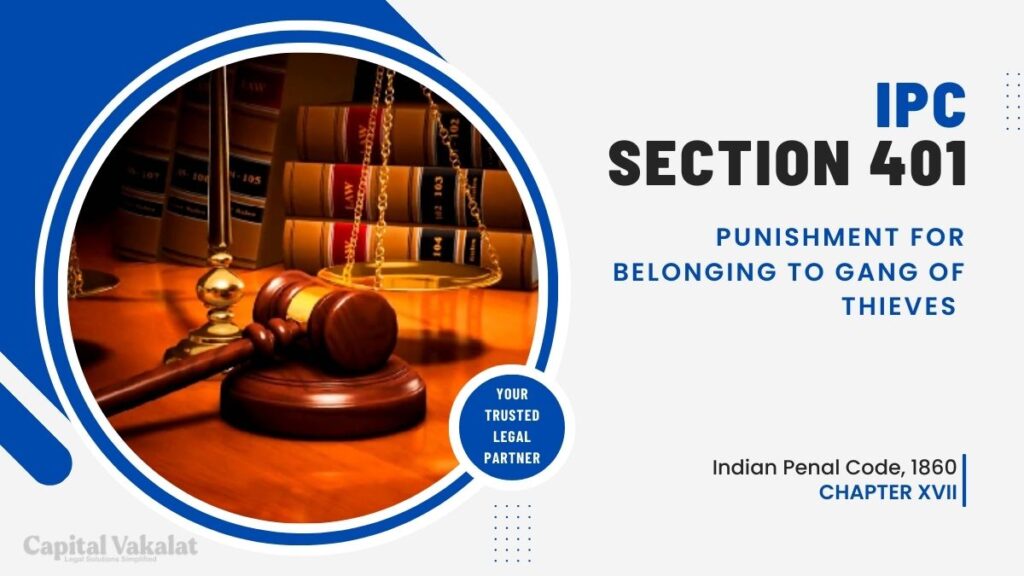In the labyrinth of legalities, Section 401 IPC stands as a formidable sentinel, casting its gaze upon those who dare to tread the path of criminal camaraderie.

Understanding the ramifications of being associated with a gang of thieves requires a deep dive into the legal intricacies, where the penal code acts as both a guide and a stern disciplinarian.
Introduction: The Shadows of Section 401 IPC
Stepping into the shadows of Section 401 IPC reveals a world where the law takes a firm stance against those who choose the life of a thief, condemning not only the act but the association with a gang engaged in such criminal activities. This article endeavors to shed light on the nuances of this section, navigating through its clauses and implications.
The Genesis of Section 401 IPC
Before delving into the punitive measures, it’s crucial to understand the genesis of Section 401 IPC. Enshrined in the Indian Penal Code, this section emerged as a response to the growing menace of organized theft and the need to curtail the influence of criminal gangs. Its roots trace back to a time when societal order was constantly threatened by the collusion of individuals in the pursuit of unlawful gains.
Decoding the Language: Section 401 IPC Unveiled
In the legal landscape, language is paramount. Section 401 IPC employs a meticulous choice of words to articulate its intent. Unraveling the text requires an examination of phrases such as “belonging to a gang of thieves” – a phrase that serves as the linchpin for the subsequent legal proceedings. Here, the law makes a clear distinction between individual criminal acts and the association with a collective entity engaged in theft.
The Punitive Measures: Section 401 IPC in Action
Now, let’s turn our gaze to the heart of the matter – the punitive measures outlined in Section 401 IPC. The law prescribes stringent penalties for those found guilty of belonging to a gang of thieves. Imprisonment, fines, and other legal consequences loom large, reflecting society’s intolerance towards organized criminality. The severity of the punishment mirrors the gravity of the offense, underscoring the legislative intent to deter and punish.
Navigating the Legal Landscape: Case Studies and Precedents
To fully grasp the implications of Section 401 IPC, it’s imperative to navigate the legal landscape through real-world case studies and precedents. Examining notable cases where this section was invoked provides insights into how the judiciary interprets and applies the law. These instances serve as guideposts, illustrating the wide-ranging scenarios where the long arm of Section 401 IPC can reach.
The Complex Web of Legal Defenses
Just as any legal provision, Section 401 IPC allows for defenses to be raised. Navigating the complex web of legal defenses requires a nuanced understanding of the circumstances surrounding the alleged association with a gang of thieves. From lack of criminal intent to mistaken identity, individuals facing charges under this section may find solace in a well-constructed defense strategy.
Perplexity and Burstiness: Section 401 IPC in the Modern Context
In an era marked by technological advancements and evolving criminal methodologies, Section 401 IPC encounters new challenges. The concepts of perplexity and burstiness, akin to the burst of criminal activities and the complexity of modern-day theft, become crucial in understanding the continued relevance and adaptability of this legal provision.
Conclusion: Navigating the Legal Maze of Section 401 IPC
In conclusion, Section 401 IPC emerges as a sentinel not only guarding against individual criminal acts but also against the insidious influence of organized theft. Navigating its legal maze requires a keen understanding of its genesis, language, punitive measures, and the evolving legal landscape. As society grapples with the perennial issue of criminality, this section stands tall, a testament to the collective will to maintain order and justice.
Frequently Asked Questions
What factors influence the severity of punishment under Section 401 IPC?
The severity of punishment can be influenced by factors such as the scale of criminal activities, the individual’s role in the gang, and any previous criminal record.
Are there any proposed amendments to Section 401 IPC?
As of the latest information, there haven’t been significant proposed amendments. However, legal provisions are subject to periodic review.
How has Section 401 IPC evolved over the years?
The section has evolved through amendments and landmark cases, adapting to the changing nature of organized crime and legal perspectives.
Can the definition of a “gang of thieves” be ambiguous in certain situations?
Yes, defining a “gang of thieves” can be challenging, and the interpretation may vary based on legal perspectives and specific circumstances.